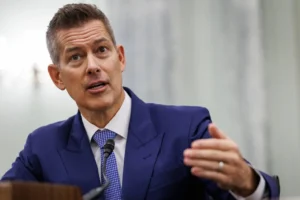 U.S. Transportation Secretary Sean Duffy told Congress on July 23 that it will cost $31.5 billion to fully modernize the nation’s air traffic control (ATC) system, a sweeping upgrade the Department of Transportation (DOT) hopes to complete by 2028. It’s the first time a specific price has been publicly tied to the project.
U.S. Transportation Secretary Sean Duffy told Congress on July 23 that it will cost $31.5 billion to fully modernize the nation’s air traffic control (ATC) system, a sweeping upgrade the Department of Transportation (DOT) hopes to complete by 2028. It’s the first time a specific price has been publicly tied to the project.
Speaking before the House Transportation and Infrastructure Committee, Duffy emphasized the urgency. “We’re talking about $31.5 billion to finish the job,” he said. “We’ll need more money, and my hope is that we’ll continue this conversation. Time is of the essence.”
The plan, first announced in May, outlines a full-scale transformation of the current system. That includes installing over 25,000 new radios, 475 voice switches, and replacing 618 radars…if Congress agrees to fund it. A $12.5 billion initial investment, secured through President Trump’s recently passed infrastructure bill, gives the project its starting boost.
Lawmakers pressed Duffy on whether the timeline is realistic, especially for the digital backbone of the system. He acknowledged that the new software, which he called “the heart” of ATC modernization, has yet to be selected. “Imagine using Microsoft 95 when the world has moved on,” Duffy said. “That’s where we are.”
He estimated the process of selecting a vendor for the software would take six to eight months, followed by another six to ten months of debugging and testing before rollout.
One possible player in the mix: Elon Musk’s Starlink. Duffy confirmed the satellite company could potentially bid on aspects of the new system requiring space-based communications, despite earlier concerns about conflicts of interest.
Those concerns were raised by Rep. Julia Brownley (D-Calif.), who referenced a March letter to the FAA flagging issues with SpaceX employees acting as consultants to the agency, while Musk was still a member of the Department of Government Efficiency (DOGE). According to Brownley, the FAA admitted on July 15 that waivers were granted despite conflicts.
Duffy responded by stressing boundaries were in place. “They were specifically walled off from anything space-related,” he said. “They focused strictly on the air traffic control side. They met with controllers and our tech teams to understand the system’s limitations.”
Still, Brownley questioned whether SpaceX should be allowed to participate in the modernization effort. Duffy left the door open, saying Starlink could bid on future projects that involve satellite connectivity.
The pilot training rule…
Outside of system upgrades, the hearing also touched on a separate safety issue: the 1,500-hour pilot training rule. The regulation, introduced after the 2009 crash of Continental Connection Flight 3407, mandates that airline pilots log at least 1,500 flight hours before flying for commercial carriers. That crash killed 50 people and was blamed on pilot error.
New FAA Administrator Bryan Bedford, formerly the CEO of Republic Airways, has not committed to upholding the rule, prompting concern on Capitol Hill. Duffy, however, signaled no intention to back away from the requirement.
“I have no plans to change it,” he said. “But if there’s data showing that advanced simulators can offer training pilots can’t get in small planes—training that truly prepares them for emergencies—then of course I’d be open to that discussion. We all want pilots who are genuinely ready.”
The upshot: Sweeping change is coming to U.S. airspace, but it won’t come cheap…and it won’t come fast.
The modernization of America’s air traffic control system is a massive, multi-decade effort that will require billions in funding, bold political will, and sustained coordination across government and industry.
From satellite-based navigation to AI-assisted routing and upgraded communications infrastructure, the overhaul promises to boost safety, cut delays, and handle the surge in both commercial and unmanned aircraft. But the price tag is steep, and the timeline stretches well into the next decade, meaning travelers and taxpayers alike will need to buckle up for the long haul.